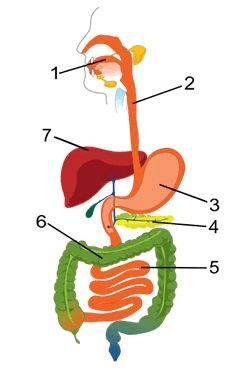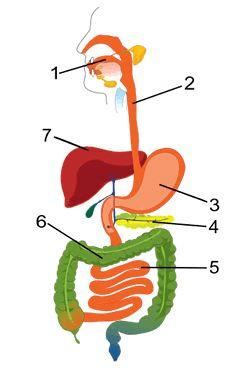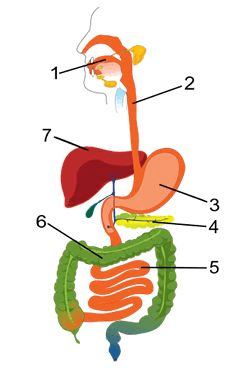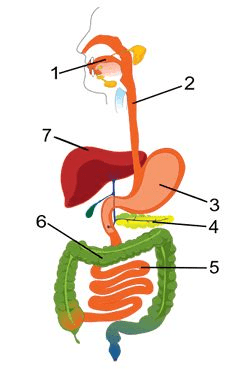This is the amount of energy needed to raise the temperature of one gram of water by one Celsius degree.
What is a calorie?
Thirty percent of your daily dietary intake should come from one of these two categories.
What are grains/carbs or vegetables?
This is the fluid in your mouth that releases enzymes, starting chemical digestion.
What is saliva?
This is where most nutrients are absorbed into the blood.
What is the small intestine?
This is number 2 on the diagram below.
What is the esophagus?
These are the substances in food that provide the raw materials and energy the body needs to carry out all the essential processes.
What are nutrients?
This can show you the nutritional content of food purchased in a store.
What is a nutritional label?
Mechanical digestion begins here.
What is the mouth?
These are tiny hair-like structures that give the small intestine a larger surface area.
What are villi?
This is number 4 on the diagram below.
What is the pancreas?
These are the two different types of carbohydrates.
What are simple and complex carbohydrates?
This is the most important nutrient in your body.
What is water?
This is the process by which nutrient molecules pass through the wall of your digestive system into your blood.
What is absorption?
Water is removed in preparation for elimination in this organ.
What is the large intestine?
This is number 7 on the diagram below.

What is liver?
This type of fat is solid at room temperature.
What is saturated fat?
Less than 10% of your diet should come from one of these two food groups.
What is dairy or sweets?
This is the involuntary muscle action that keeps food moving in one direction.
What is peristalsis?
This substance that breaks up fat particles is called ____________ and is produced in the ____________.
What is the bile, which is produced in the liver?
This is number 5 on the diagram below.
What is the small intestine?
These are nutrients that are not made by living things.
What are minerals?
Vitamin K is another name for this nutrient.
What is potassium?
This seals off the windpipe, preventing the food from entering the trachea.
What is the epiglottis?
Mechanical digestion takes place in these two locations during the digestive process.
What are the mouth and the stomach?
This is number 3 on the diagram below.

What is the stomach?